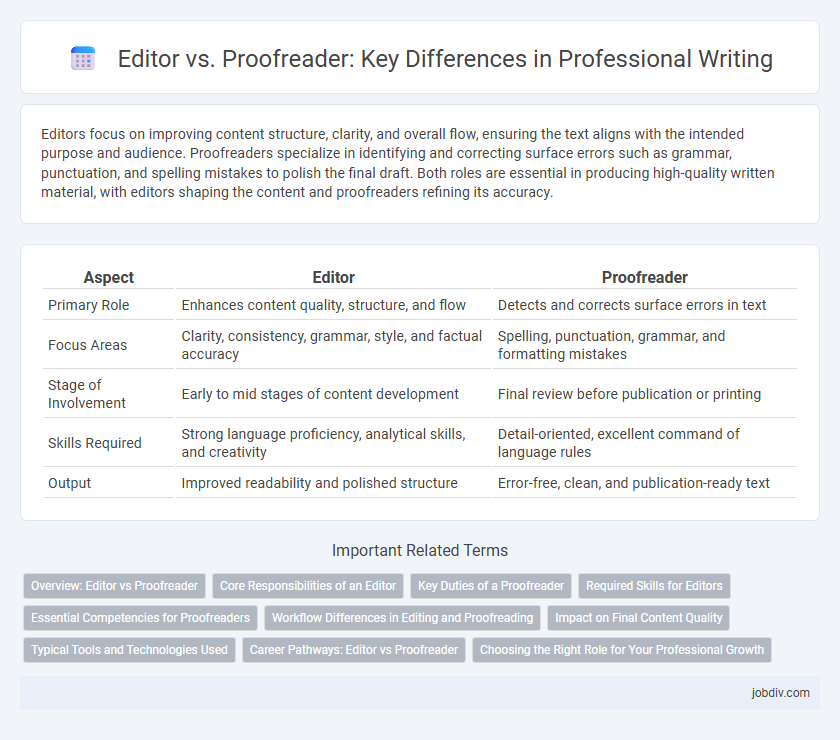Editors focus on improving content structure, clarity, and overall flow, ensuring the text aligns with the intended purpose and audience. Proofreaders specialize in identifying and correcting surface errors such as grammar, punctuation, and spelling mistakes to polish the final draft. Both roles are essential in producing high-quality written material, with editors shaping the content and proofreaders refining its accuracy.
Table of Comparison
| Aspect | Editor | Proofreader |
|---|---|---|
| Primary Role | Enhances content quality, structure, and flow | Detects and corrects surface errors in text |
| Focus Areas | Clarity, consistency, grammar, style, and factual accuracy | Spelling, punctuation, grammar, and formatting mistakes |
| Stage of Involvement | Early to mid stages of content development | Final review before publication or printing |
| Skills Required | Strong language proficiency, analytical skills, and creativity | Detail-oriented, excellent command of language rules |
| Output | Improved readability and polished structure | Error-free, clean, and publication-ready text |
Overview: Editor vs Proofreader
Editors focus on improving content structure, clarity, and overall flow, ensuring the text aligns with the intended purpose and target audience. Proofreaders specialize in identifying and correcting grammatical, spelling, punctuation, and formatting errors to ensure accuracy and consistency. Both roles are essential in the publishing process, with editors refining the message and proofreaders polishing the final presentation.
Core Responsibilities of an Editor
Editors are responsible for shaping the overall content, structure, and tone of a manuscript to ensure clarity, coherence, and engagement. They evaluate the flow of ideas, consistency of style, and accuracy of facts, often collaborating closely with authors to enhance the narrative. Core tasks include revising, reorganizing, and providing substantive feedback to elevate the quality and effectiveness of the text.
Key Duties of a Proofreader
A proofreader's key duties include meticulously reviewing text to identify and correct spelling, grammar, punctuation, and formatting errors. They ensure consistency in language usage and adherence to style guides, maintaining the document's overall accuracy and clarity. Proofreaders finalize content by eliminating typographical mistakes before publication, guaranteeing a polished and error-free presentation.
Required Skills for Editors
Editors require a deep understanding of language nuances, strong critical thinking abilities, and expertise in style guides such as APA, MLA, or Chicago. Proficiency in content organization, fact-checking, and the capacity to provide constructive feedback are essential for ensuring clarity and coherence in professional writing. Mastery of digital editing tools and attention to detail also play a vital role in the editorial process.
Essential Competencies for Proofreaders
Proofreaders must possess a keen eye for detail, exceptional grammar knowledge, and strong language proficiency to identify and correct errors in spelling, punctuation, and syntax. Proficiency with style guides such as APA, MLA, or Chicago Manual of Style ensures consistency and adherence to industry standards. Time management skills and the ability to maintain concentration over extended periods are critical for delivering accurate and polished final manuscripts.
Workflow Differences in Editing and Proofreading
Editors shape the overall structure, clarity, and coherence of a document by revising content, sentence flow, and style, ensuring alignment with the intended audience and purpose. Proofreaders perform a final review focused on identifying and correcting surface errors such as grammar, punctuation, spelling, and formatting inconsistencies. The editing workflow is intensive and iterative, involving substantial content modifications, while proofreading is the concluding step with a meticulous, detail-oriented focus on error elimination.
Impact on Final Content Quality
Editors enhance final content quality by refining structure, clarity, and flow, ensuring the message resonates effectively with the target audience. Proofreaders improve precision by eliminating grammatical, spelling, and typographical errors, providing a polished and professional appearance. Together, their contributions significantly elevate the overall readability and credibility of the final document.
Typical Tools and Technologies Used
Editors commonly utilize advanced word processing software like Microsoft Word and Google Docs, along with style guides such as the Chicago Manual of Style to ensure content accuracy and consistency. Proofreaders rely heavily on digital annotation tools, specialized proofreading software like Grammarly or PerfectIt, and tracking features within document editors to identify and correct typographical and grammatical errors. Both professionals often use collaboration platforms such as Slack or Trello to communicate and manage workflow effectively.
Career Pathways: Editor vs Proofreader
Careers in editing often require strong skills in content development, structure, and style refinement, allowing editors to influence the overall narrative and clarity of a manuscript or publication. Proofreading careers focus on meticulous error detection, including grammar, punctuation, and formatting consistency, ensuring the final product is polished and free of mistakes. Editors typically advance into senior or managerial roles, while proofreaders may specialize in specific industries or combine their skills with other editorial functions for broader career opportunities.
Choosing the Right Role for Your Professional Growth
Selecting between an editor and a proofreader depends on your career goals and skills; editors enhance content structure, clarity, and style, while proofreaders focus on correcting grammar, punctuation, and spelling errors. Professionals seeking to shape the overall narrative and improve coherence should pursue editing roles, whereas those detail-oriented with a focus on error detection may thrive as proofreaders. Understanding the distinct responsibilities and impact of each role facilitates strategic professional growth in publishing, marketing, or content creation industries.
Editor vs Proofreader Infographic

 jobdiv.com
jobdiv.com